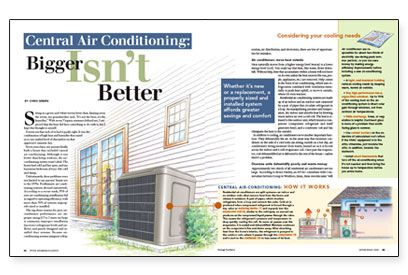Central Air Conditioning: Bigger Isn’t Better
Whether it's new or a replacement, a properly sized and installed system affords greater savings and comfort.

Synopsis: Whether upgrading your underpowered air conditioning system, or installing a brand new unit, it is important to know exactly what you need. If you get one too small, you’ll be left in the heat, but go too big, and you run the risk of having a damp house and an empty wallet. The key is to choose the right size, and this article will help you do just that. Additionally, the article includes a sidebar containing inexpensive, energy-efficient improvements you can make in order to counteract the costs of running central air.
Sitting in a green-and-white woven lawn chair, fanning away the sweat, my grandmother said, “It’s not the heat, it’s the humidity.” With seven Virginia summers behind me, I suspected that the heat did have something to do with it, but I kept this thought to myself.
It turns out that each of us had it partly right. It was the combination of high heat and humidity that raised us to our exalted level of discomfort on that oppressive summer day.
Seven years later, my parents finally built a house that included central air conditioning. Although it was better than being without, the air-conditioning system wasn’t ideal. The house had cold and hot spots, and my basement bedroom always felt cold and damp.
Unfortunately, these problems were not limited to my parents’ house nor to the 1970s. Problematic air-conditioning systems abound nationwide. According to a recent study, 95% of new air-conditioning installations fail in regard to operating efficiency, with more than 70% of systems improperly sized or installed.
The top three reasons for poor air-conditioner performance are improper sizing (1.5 to 2 times too large is common); improper installation (incorrect refrigerant levels and airflow); and poorly designed and installed duct systems. Because air-conditioning systems integrate refrigeration, air distribution, and electronics, there are lots of opportunities for mistakes.
Air conditioners move heat outside
Heat naturally moves from a higher energy level (warm) to a lower energy level (cool). You could say that heat, like water, flows downhill. Without help, heat that accumulates within a home will not leave on its own unless the heat sources (the sun, people, appliances, etc.) are removed. Help comes in the form of air conditioning, which uses refrigeration combined with ventilation essentially to push heat uphill, or move it outside, where it’s even warmer.
Residential air-conditioning systems are made up of an indoor and an outdoor unit connected by a pair of pipes that circulate refrigerant in a loop. By manipulating pressure and temperature, the indoor unit absorbs heat by blowing warm indoor air over a cold coil. The heat is released to the outdoor unit, which houses a compressor (compresses refrigerant and itself generates heat), and a condenser coil and fan (dissipates the heat to the outside).
In addition to cooling, air conditioners serve another important function: They dehumidify the air. In the same way that moisture condenses on the side of a cold soda can sitting outside on a hot day, air conditioners wring moisture from warm, humid air as it is forced across the indoor unit’s cold evaporator coil. Once past the evaporator, cool dehumidified air is delivered to the rest of the house—unless there’s a problem.
For more photos and details, click the View PDF button below:
Fine Homebuilding Recommended Products
Fine Homebuilding receives a commission for items purchased through links on this site, including Amazon Associates and other affiliate advertising programs.

Pretty Good House

All New Bathroom Ideas that Work

All New Kitchen Ideas that Work

























